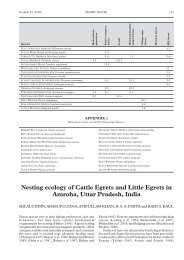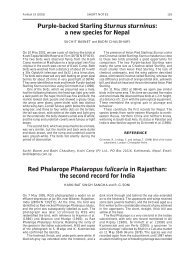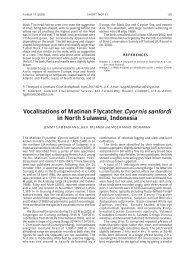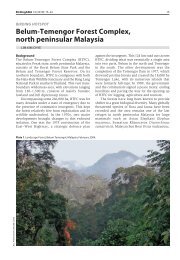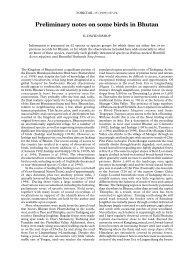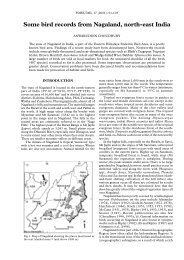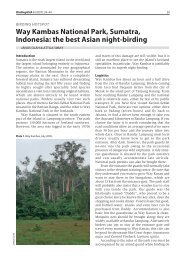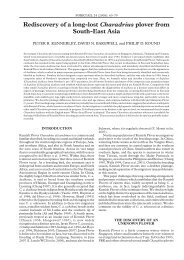Birds of Kaziranga National Park, India - Oriental Bird Club
Birds of Kaziranga National Park, India - Oriental Bird Club
Birds of Kaziranga National Park, India - Oriental Bird Club
You also want an ePaper? Increase the reach of your titles
YUMPU automatically turns print PDFs into web optimized ePapers that Google loves.
Forktail 15 (1999) <strong><strong>Bird</strong>s</strong> <strong>of</strong> <strong>Kaziranga</strong> <strong>National</strong> <strong>Park</strong>, <strong>India</strong><br />
51<br />
sporadically throughout the <strong>Park</strong> on Bombax ceiba trees.<br />
The global population is estimated to be below 10,000<br />
individuals, and is still declining (Rose and Scott 1994).<br />
135 nests were recorded during a survey in Assam<br />
(Hancock et. al. 1992). Other records: up to 80 were<br />
seen on 30-31 January 1971 (Inskipp 1971), eight at<br />
Sohola on 28 December and two near Baguri on 29<br />
December 1993 (Kovacs 1994), up to 50 in February<br />
1994 (Alström et al. 1994), several on 17 and c. 20 on<br />
18 March 1994, two on 25 and 10+ between 27-29<br />
March 1996 (K. Kazmierczak in litt.), one to four daily<br />
12-15 March 1998 (P. Holt in Hornbuckle et al. 1998).<br />
BLUE-NAPED PITTA Pitta nipalensis (NT). Rare winter<br />
visitor. Noted in tea gardens and at Panbari. Other<br />
records: recorded by Sonowal (1978).<br />
BLACK-BREASTED T HRUSH Turdus dissimilis (NT). Two seen<br />
at Panbari on 12 March 1992 (Redman 1992); one in<br />
Sohola (Agaratoli) in November 1997 (P. Pavlovic pers.<br />
comm.)<br />
HODGSON’S BUSHCHAT Saxicola insignis (VU). Seen in<br />
Dunga and other areas <strong>of</strong> Baguri range during April<br />
1995 (Sarma et al. 1997). The only previous records<br />
from Assam were from Manas <strong>National</strong> <strong>Park</strong> (Narayan<br />
and Rosalind 1997). The only locality in the <strong>India</strong>n<br />
subcontinent where it used to be seen regularly was Kosi<br />
Barrage in Nepal, where up to 10 used to occur annually<br />
(Inskipp and Inskipp 1991), suggesting that it may have<br />
declined, possibly as a result <strong>of</strong> the modification <strong>of</strong> its<br />
grassland and wetland habitat (Rahmani 1986).<br />
JERDON’S BUSHCHAT Saxicola jerdoni (NT). Very rare.<br />
Noted in grasslands dominated by Erianthus, <strong>of</strong>ten near<br />
water. Other records: one was seen on 1 February 1971<br />
(Inskipp 1971).<br />
SPOT-WINGED STARLING Saroglossa spiloptera (NT). Fairly<br />
common migrant. Some birds arrive in July although<br />
there is maximum concentration during February-<br />
March when the Silk Cotton Bombax ceiba is in blossom.<br />
Other records: up to 2,000 seen in February 1994<br />
(Alström et al. 1994).<br />
BRAHMINY STARLING Sturnus pagodarum. About 15 were<br />
seen in Sohola Kathoni (Agaratoli) on 14 January 1994.<br />
Previously recorded as a straggler to Assam (Choudhury<br />
1990a).<br />
WALLCREEPER Tichodroma muraria. One was seen in<br />
Murkhuwa (Baguri) on 19 December 1994; the first<br />
record for Assam.<br />
RUFOUS-VENTED PRINIA Prinia burnesii (VU). Seen once<br />
by A. Choudhury (pers. comm.).<br />
YELLOW-VENTED WARBLER Phylloscopus cantator (NT).<br />
Uncommon winter migrant. Commoner in semievergreen<br />
forest at Panbari but also present in moist<br />
deciduous forest in the park. Other records: two were<br />
seen on 10 March 1992 (Redman 1992) and 10 were<br />
seen in February 1994 (Alström et al. 1994).<br />
LESSER WHITETHROAT Sylvia curruca. Seen on 14<br />
December 1993 in Rongamotia (Agaratoli). Previously<br />
recorded in Assam only by Choudhury (1990a).<br />
BRISTLED GRASSBIRD Chaetornis striatus (VU). At least<br />
three singing males at Debeswari (Agaratoli) on 18<br />
March 1999. The birds were seen in grassland consisting<br />
<strong>of</strong> Phragmites and Erianthus. Subsequent survey in the<br />
area revealed at least another three birds (22-24 April<br />
1999). Other records: one seen near Mihimukh on 14<br />
March 1989 (Redman 1989). This overlooked species<br />
is probably resident in the park. There are very few recent<br />
records <strong>of</strong> this species from <strong>India</strong> (Inskipp 1996), and it<br />
may be threatened by the widespread destruction and<br />
modification <strong>of</strong> grassland and wetland habitats within<br />
its range (Collar et al. 1994).<br />
MARSH BABBLER Pellorneum palustre (VU). Four or five<br />
were seen next to Daphlang Beel (Kohora) on 31<br />
January 1995. It has also been seen by G. Narayan (pers.<br />
comm.). There are recent records from only three<br />
protected areas <strong>of</strong> north-east <strong>India</strong>. It is threatened by<br />
the fragmentation and destruction <strong>of</strong> its grassland and<br />
wetland habitat (Rahmani 1986).<br />
JERDON’S BABBLER Chrysomma altirostre (VU). An<br />
uncommon resident seen mostly in grassland dominated<br />
by Saccharum and Erianthus.<br />
SLENDER-BILLED BABBLER Turdoides longirostris (NT). Very<br />
rare resident. A pair was observed in moist grassland<br />
consisting mainly <strong>of</strong> Erianthus near Dunga (Baguri) in<br />
November 1993. Other records: a group <strong>of</strong> 14 birds at<br />
Daphlang (Kohora) on 16 March 1996 (Bishop 1996).<br />
BLACK-BREASTED PARROTBILL Paradoxornis flavirostris<br />
(VU). Recorded at Dhansirimukh by Stevens (1915).<br />
Subsequently recorded as occurring in <strong>Kaziranga</strong> by<br />
Collar et al. (1994). A pair was observed at Debeswari<br />
on 27 March 1998. A subsequent search in the area<br />
revealed that the birds were partial to Phragmites reeds,<br />
on which the birds seem to feed. Two different calls were<br />
noted: (1) a phew phew phew phuit... as noted by Stevens<br />
(1915) and (2) a bleating croing, croing, croing, croing...<br />
repeated four or five times. Dhansirimukh, where<br />
Stevens recorded this species, is c. 3 km east <strong>of</strong><br />
Debeswari.<br />
FINN’S WEAVER Ploceus megarhynchus (VU). An<br />
uncommon resident inhabiting grasslands. 30-40 nests<br />
were seen on a Bombax tree at Bahu Beel (Baguri). It is<br />
an extremely local resident in Assam, with records from<br />
only three protected areas. Destruction and modification<br />
has led to severe fragmentation <strong>of</strong> its grassland habitat<br />
(Rahmani 1986).<br />
We are grateful to the Director, D.F.O. and all the staff <strong>of</strong> <strong>Kaziranga</strong><br />
<strong>National</strong> <strong>Park</strong>. We would like to thank Rishad Naoroji, who encouraged<br />
us to publish our records, and commented on an earlier draft,<br />
especially on the raptor section. Dr. Asad Rahmani provided us constant<br />
guidance and it is due to his efforts that the paper has taken its<br />
present shape. We are indebted to Manju Barua for his support<br />
throughout the various stages <strong>of</strong> our work. There are a lot <strong>of</strong> people<br />
whose co-operation during our work was <strong>of</strong> great help: Prasanna<br />
Barua <strong>of</strong> ARSAC for the map; Annamarie Lyles, who kindly sent us



